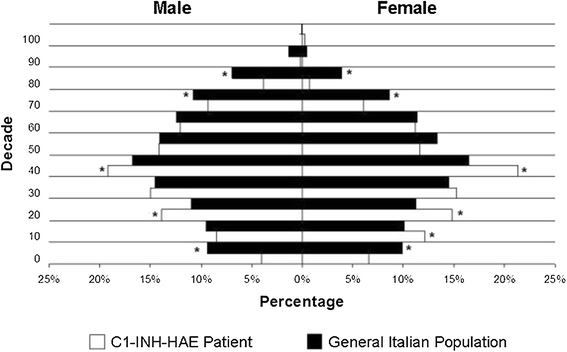A nationwide survey of hereditary angioedema due to C1 inhibitor deficiency in Italy
- PMID: 25758562
- PMCID: PMC4333895
- DOI: 10.1186/s13023-015-0233-x
A nationwide survey of hereditary angioedema due to C1 inhibitor deficiency in Italy
Abstract
Introduction: Hereditary angioedema due to C1-inhibitor deficiency (C1-INH-HAE type I) or dysfunction (C1-INH-HAE type II) is a rare disease characterized by recurrent episodes of edema with an estimated frequency of 1:50,000 in the global population without racial or gender differences. In this study we present the results of a nationwide survey of C1-INH-HAE patients referring to 17 Italian centers, the Italian network for C1-INH-HAE, ITACA.
Methods: Italian patients diagnosed with C1-INH-HAE from 1973 to 2013 were included in the study. Diagnosis of C1-INH-HAE was based on family and/or personal history of recurrent angioedema without urticaria and on antigenic and/or functional C1-INH deficiency.
Results: 983 patients (53% female) from 376 unrelated families were included in this survey. Since 1973, 63 (6%) patients diagnosed with C1-INH-HAE died and data from 3 patients were missing when analysis was performed. Accordingly, the minimum prevalence of HAE in Italy in 2013 is 920:59,394,000 inhabitants, equivalent to 1:64,935. Compared to the general population, patients are less represented in the early and late decades of life: men start reducing after the 5(th) decade and women after the 6(th). Median age of patients is 45 (IQ 28-57), median age at diagnosis is 26 years (IQ 13-41). C1-INH-HAE type 1 are 87%, with median age at diagnosis of 25 (13-40); type 2 are 13% with median age at diagnosis of 31 (IQ 16-49). Functional C1INH is ≤50% in 99% of patients. Antigen C1INH is ≤50% in 99% of type 1. C4 is ≤50% in 96% of patients. The chance of having C1-INH-HAE with C4 plasma levels >50% is < 0.05.
Conclusion: This nationwide survey of C1-INH-HAE provides for Italy a prevalence of 1:64,935. C1-INH-HAE patients listed in our database have a shorter life expectancy than the general population. An increased awareness of the disease is needed to reduce this discrepancy. Measurement of C4 antigen can exclude diagnosis of C1-INH-HAE with an accuracy > 95%. This parameter should be therefore considered for initial screening in differential diagnosis of angioedema.
Figures
References
-
- Agostoni A, Aygören-Pürsün E, Binkley KE, Blanch A, Bork K, Bouillet L, et al. Hereditary and acquired angioedema: problems and progress: proceedings of the third C1 esterase inhibitor deficiency workshop and beyond. J Allergy Clin Immunol. 2004;114:S51–131. doi: 10.1016/j.jaci.2004.06.047. - DOI - PMC - PubMed
MeSH terms
LinkOut - more resources
Full Text Sources
Other Literature Sources
Miscellaneous



